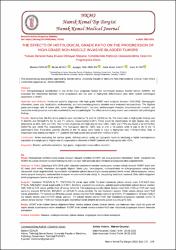| dc.contributor.author | Öznur, Meltem | |
| dc.contributor.author | İsal Arslan, Ayşegül | |
| dc.contributor.author | Akgül, Murat | |
| dc.contributor.author | Yazıcı, Cenk Murat | |
| dc.contributor.author | Altın, Enes | |
| dc.date.accessioned | 2022-05-11T14:10:02Z | |
| dc.date.available | 2022-05-11T14:10:02Z | |
| dc.date.issued | 2020 | |
| dc.identifier.issn | 2587-0262 | |
| dc.identifier.issn | 2587-0262 | |
| dc.identifier.uri | https://doi.org/10.37696/nkmj.730161 | |
| dc.identifier.uri | https://app.trdizin.gov.tr/makale/TkRZd01URTVPUT09 | |
| dc.identifier.uri | https://hdl.handle.net/20.500.11776/5255 | |
| dc.description.abstract | Aim: Histopathological classification is one of the main prognostic factors for non-muscle invasive bladder tumors (NMIBT). Weevaluated the relationship between tumor progression and the ratio of high-grade differentiation plus other routine pathologicalparameters in NMIBT.Materials and Methods: Ninety-two patients diagnosed with high grade NIMBT were analyzed between 2010-2018. Demographicinformation, tumor size, localization, multicentricity, and recurrence/progression situation were evaluated retrospectively. The high/lowgrade percentage ratio of tumor cells, tumor stage, differentiation, necrosis, lamina-propria invasion, lymphovascular invasion, andcarcinoma in-situ presence were also examined by two uro-pathologist. The effect on tumor progression was evaluated with pathologicalfindings.Results: Seventy-four (80.4%) of the patients were reported as T1 and 18 (19.6%) as Ta. The mean ratio of high-grade findings was11.9±8.5% and 69.5±28.1% for Ta and T1 patients, respectively(p<0.001). Three levels for classification of high degree ratio weredetermined as 25%, 50% and 75%. The number of patients with high degree ratio >25%, >50% and >75% was found to be 67(72.8%),54(58.7%) and 43(46.7%), respectively. The high-grade ratio for >25% was in only 1 Ta patient while it was in 66 of the T1patients(p<0.001). Forty-three patients (58.1%) in the T1 group were found to have a high-grade ratio >75%(p<0.001). Rate ofprogression was statistically higher in T1 patients with high-grade ratio greater than >50%(p=0.025).Conclusion: When evaluating the nuclear grade, defining tumors solely as high-grade leads to stratifying a highly heterogeneouspopulation in a single group. Higher rate of progression is observed in NIMBT patients with high-grade ratio >50%. | en_US |
| dc.description.abstract | KİOMT’de yüksek dereceli hücresel farklılaşma oranı ve diğer rutin patolojik parametrelerin progresyona etkisi değerlendirildi. Materyal ve Metot: Çalışmaya 2010-2018 yılları arasında transüretral mesane rezeksiyonu sonrası yüksek dereceli KİOMT tanısı alan 92 hasta dahil edildi. Hastaların demografik bilgileri, tümör çapı, lokalizasyonu, multisantrisitesi ve nüks/progresyon varlığı-süresi retrospektif olarak değerlendirildi. Ayrıca tümör hücrelerinin yüksek derece/düşük derece yüzdesi, tümör evresi, diferansiyasyon, nekroz, lamina propria invazyonu, lenfovasküler invazyon ve karsinoma in-situ varlığı iki üro-patolog tarafından incelendi. Elde edilen bulguların tümör progresyonu üzerine etkisi araştırıldı. Bulgular: Hastaların 74’ü(%80,4) T1, 18’i(%19,6) Ta olarak rapor edildi. Ta tanılı hastalarda yüksek derece oranı %11,9±8,5 iken, T1’lerde %69,5±28,1 olarak tespit edildi (p<0.001). Sınıflama yapılabilmesi amacıyla, patoloji spesimenlerindeki yüksek derece oranları; %25, %50 ve %75 olacak şekilde 3 cut-off seviye belirlendi. Tüm çalışma grubunda yüksek derece oranı>%25,>%50 ve>%75 olan hasta sayısının sırasıyla 67(%72,8), 54(%58,7) ve 43(%46,7) olduğu görüldü. Ta olan hastaların sadece 1’inde yüksek derece oranı>%25 olarak gözlenirken, T1 hastalarının 66’sında yüksek derece oranının>%25 olduğu belirlendi (p<0.001). T1 hastalarının 43’ünde (%58,1) ise yüksek derece oranının>%75 olduğu görüldü. T1 yüksek derece oranları>%50 olan hastalarda progresyon, patolojik evresi T1 yüksek derece oranları <%50 olan hastalara göre istatistiksel olarak anlamlı derecede yüksek bulundu (p=0.025). Sonuç: KİOMT’lerde nükleer derece değerlendirilirken tümöre sadece yüksek dereceli demek, çok heterojen olan büyük bir grubu tek başlık altında toplamamıza neden olmaktadır. KİOMT’lerde yüksek derece oranları>%50 olan hastalarda progresyon anlamlı derecede artmaktadır. | en_US |
| dc.language.iso | eng | en_US |
| dc.identifier.doi | 10.37696/nkmj.730161 | |
| dc.rights | info:eu-repo/semantics/openAccess | en_US |
| dc.title | The Effects of Histological Grade Ratio on the Progression of High-Grade Non-Muscle Invasive Bladder Tumors | en_US |
| dc.title.alternative | Yüksek Dereceli Kasa İnvaze Olmayan Mesane Tümörlerinde Histolojik Derecelendirme Oranının Progresyona Etkisi | en_US |
| dc.type | article | en_US |
| dc.relation.ispartof | Namık Kemal Tıp Dergisi | en_US |
| dc.department | Fakülteler, Tıp Fakültesi, Cerrahi Tıp Bilimleri Bölümü, Tıbbi Patoloji Ana Bilim Dalı | en_US |
| dc.department | Fakülteler, Tıp Fakültesi, Dahili Tıp Bilimleri Bölümü, İç Hastalıkları Ana Bilim Dalı | en_US |
| dc.department | Fakülteler, Tıp Fakültesi, Cerrahi Tıp Bilimleri Bölümü, Üroloji Ana Bilim Dalı | en_US |
| dc.identifier.volume | 8 | en_US |
| dc.identifier.issue | 2 | en_US |
| dc.identifier.startpage | 271 | en_US |
| dc.identifier.endpage | 278 | en_US |
| dc.institutionauthor | Öznur, Meltem | |
| dc.institutionauthor | İsal Arslan, Ayşegül | |
| dc.institutionauthor | Akgül, Murat | |
| dc.institutionauthor | Yazıcı, Cenk Murat | |
| dc.institutionauthor | Altın, Enes | |
| dc.identifier.trdizinid | TkRZd01URTVPUT09 | en_US |



















